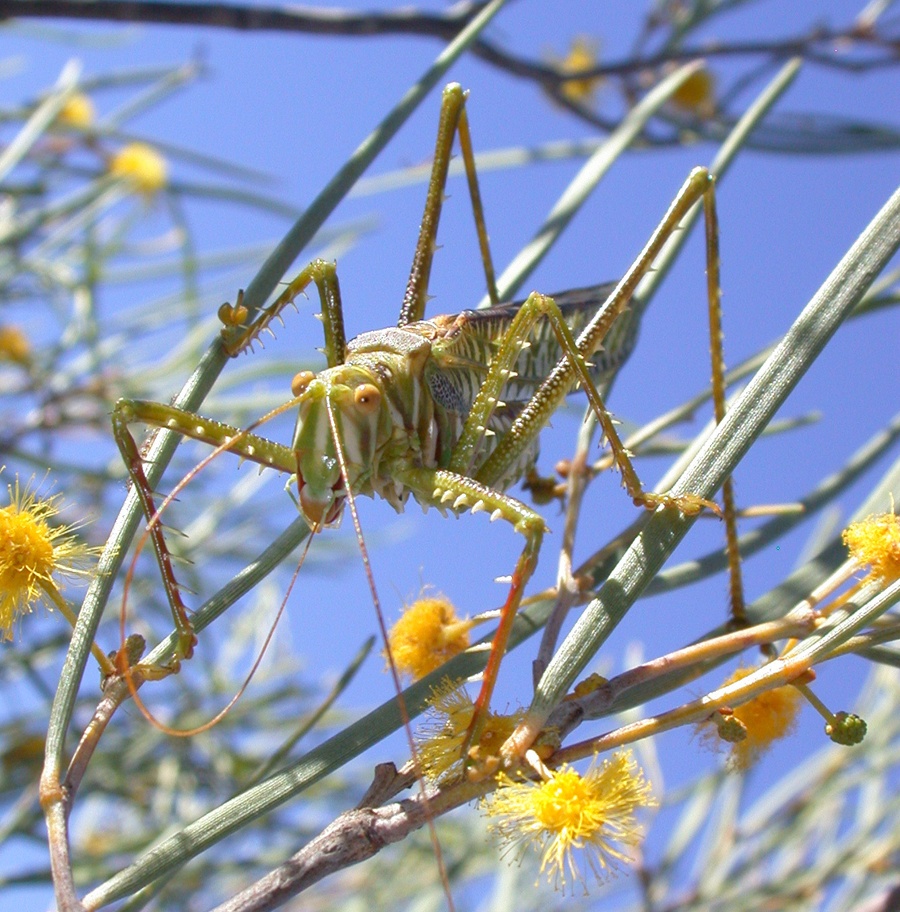Chlorobalius leucoviridis on:
[Wikipedia]
[Google]
[Amazon]
''Chlorobalius'' is a
 ''Chlorobalius leucoviridis'' is native to arid, inland regions of Australia. It is typically found high in a large bush or small tree.
''Chlorobalius leucoviridis'' is native to arid, inland regions of Australia. It is typically found high in a large bush or small tree.
species
In biology, a species is the basic unit of classification and a taxonomic rank of an organism, as well as a unit of biodiversity. A species is often defined as the largest group of organisms in which any two individuals of the appropriate s ...
of long-horned grasshopper
Grasshoppers are a group of insects belonging to the suborder Caelifera. They are among what is possibly the most ancient living group of chewing herbivorous insects, dating back to the early Triassic around 250 million years ago.
Grasshopp ...
in the family
Family (from la, familia) is a Social group, group of people related either by consanguinity (by recognized birth) or Affinity (law), affinity (by marriage or other relationship). The purpose of the family is to maintain the well-being of its ...
Tettigoniidae
Insects in the family Tettigoniidae are commonly called katydids (especially in North America), or bush crickets. They have previously been known as "long-horned grasshoppers". More than 8,000 species are known. Part of the suborder Ensifera, t ...
containing the only species, ''Chlorobalius leucoviridis'', commonly known as the spotted predatory katydid. It is a predator
Predation is a biological interaction where one organism, the predator, kills and eats another organism, its prey. It is one of a family of common feeding behaviours that includes parasitism and micropredation (which usually do not kill th ...
and is an acoustic aggressive mimic
Aggressive mimicry is a form of mimicry in which predators, parasites, or parasitoids share similar signals, using a harmless model, allowing them to avoid being correctly identified by their prey or host. Zoologists have repeatedly compared t ...
of cicada
The cicadas () are a superfamily, the Cicadoidea, of insects in the order Hemiptera (true bugs). They are in the suborder Auchenorrhyncha, along with smaller jumping bugs such as leafhoppers and froghoppers. The superfamily is divided into two ...
s; by imitating the sounds and movements made by female cicadas
The cicadas () are a superfamily, the Cicadoidea, of insects in the order Hemiptera (true bugs). They are in the suborder Auchenorrhyncha, along with smaller jumping bugs such as leafhoppers and froghoppers. The superfamily is divided into two ...
, it lures male cicadas to within its reach and then eats them.
Taxonomy
''Chlorobalius leucoviridis'' was first described by the Prussian/Australian botanist andentomologist
Entomology () is the scientific study of insects, a branch of zoology. In the past the term "insect" was less specific, and historically the definition of entomology would also include the study of animals in other arthropod groups, such as arach ...
Johann Gottlieb Otto Tepper in 1896. It forms part of the family Tettigoniidae, the subfamily Listroscelidinae and the tribe Terpendrini, the gum-leaf katyatids.
Description
The adult ''Chlorobalius leucoviridis'' is a large, cryptically-coloured, long-horned grasshopper. The body, wings and legs are barred and spotted in green and white. The legs bear short spines and both males and females have stridulatory organs, the male has a file-and-scraper structure on thetegmen
A tegmen (plural: ''tegmina'') designates the modified leathery front wing on an insect particularly in the orders Dermaptera ( earwigs), Orthoptera (grasshoppers, crickets and similar families), Mantodea (praying mantis), Phasmatodea (stick an ...
(fore-wing) while the female has pegs on the hind wing which rub against certain veins on the fore-wing.
Distribution and habitat
 ''Chlorobalius leucoviridis'' is native to arid, inland regions of Australia. It is typically found high in a large bush or small tree.
''Chlorobalius leucoviridis'' is native to arid, inland regions of Australia. It is typically found high in a large bush or small tree.
Behaviour
''Chlorobalius leucoviridis'' is nocturnal and occurs in small groups which move from one location to another. It feeds by catching other insects such asflies
Flies are insects of the order Diptera, the name being derived from the Greek δι- ''di-'' "two", and πτερόν ''pteron'' "wing". Insects of this order use only a single pair of wings to fly, the hindwings having evolved into advanced ...
, grasshopper
Grasshoppers are a group of insects belonging to the suborder Caelifera. They are among what is possibly the most ancient living group of chewing herbivorous insects, dating back to the early Triassic around 250 million years ago.
Grasshopp ...
s and other katydid
Insects in the family Tettigoniidae are commonly called katydids (especially in North America), or bush crickets. They have previously been known as "long-horned grasshoppers". More than 8,000 species are known. Part of the suborder Ensifera, t ...
s, grasping the prey with its fore-legs or first two pairs of legs, and immobilising it by biting it under the throat. The spines on the legs seem to play a part in controlling larger prey items. The male makes loud, trilling songs to lead females of its own species towards its location.
The male attracts male cicadas on which to feed by mimicry, luring them to its vicinity by deception. This is accomplished both acoustically, by audible wing-clicking in a pattern similar to that used by sexually-receptive female cicadas, and visually by the use of synchronised body movements similar to those exhibited by the females. Remarkably, the katydid has the ability to mimic the sounds and movements of a number of different prey species, even some species with which it has never had direct contact.
References
{{Taxonbar, from1=Q14625415, from2=Q10450480 Taxa described in 1896 Tettigoniidae